This is a Veteran Owned site

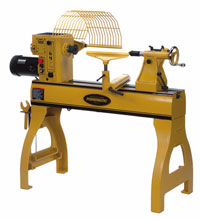 |
The Powermatic 3520B is big, pricey and totally capable. It will also save lots of money if you avoid buying smaller lathes on the way to this one! Click image to enlarge |
Powermatic 3520B Lathe
It’s heavy, powerful, full-featured and purrs like a kitten
Text, photos and video by Tom Hintz
Posted - 4-21-2007
A frequent turning related question received by NewWoodworker.com LLC goes something like, “What’s the best lathe for my shop?” Before I got the Powermatic 3520B Lathe in my shop, I didn’t have a pat answer. I still get that question – but now I have a response.
The Big Box Cometh
The biggest problem I had with the Powermatic 3520B Lathe was getting it out of the shipping carton and up on its legs. At 682 lbs, my grab, grunt and strain assembly technique was obviously inadequate and potentially dangerous to the machine and myself. Fortunately during a recent moment of clarity, I bought a hydraulic shop crane that fears no load weighing 1 ton or under.
Tip: Unless you have a solid truck and a way to get 700+ lbs or so in and out of it safely, I strongly suggest you consider having this machine delivered. Getting this lathe up and running is way easier and safer after watching a trucker lower it to the ground on a lift gate.
With the shop crane capably holding the lathe’s bed and headstock (they come assembled) at the appropriate height, bolting up the cast iron legs was easy. Incidentally, the legs are no lightweights in their own right. Install the leveling feet, one Comparator bracket (more on this later) and the Powermatic 3520B Lathe was essentially ready to use. All that remained was bolting on the tool caddy and sliding the banjo and tailstock onto the bed. Once you deal with the weight issue safely, setting up the Powermatic 3520B Lathe is remarkably fast and simple.
Electrical
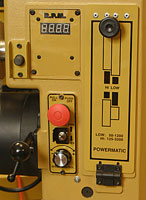 |
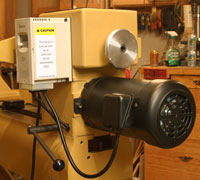 |
(left) The front-mounted control panel has everything you need to run the 3520B and all are easy to understand. (right) The gray box is the inverter that changes the single phase 220V power you have to the 3 phase 220V power that would cost thousands to get to your residential shop - if that is even possible. Click image to enlarge |
|
The Powermatic 3520B Lathe comes fully wired except for a plug to match your 220V outlet. An inverter is built into the onboard electrical system and converts the single phase 220 current usually found in residential areas to the 3 phase required by the 2Hp motor. If you don’t understand the 1-phase/3-phase stuff, suffice it to say that the included inverter makes hooking the Powermatic 3520B Lathe up in your shop simple. It’s also thousands cheaper (literally) than paying the local power company to string a 3-phase line through the neighborhood to your house, if they will do it at all.
The TEFC (totally enclosed fan cooled) motor is factory installed and requires no maintenance now or later. Running on 220V and possessing more power than you are likely to need most of the time, it seems to be loafing most of the time. That lack of strain promises a very long life.
The front panel of the headstock contains all of the controls including the variable speed dial, forward/reverse toggle switch and the pull on – push off switch. An easy to read LED panel displays spindle speed clearly and accurately.
The inverter adds a nice safety feature to the Powermatic 3520B Lathe by preventing unexpected startups. If the power is interrupted while the Powermatic 3520B Lathe is running, it won’t start up unexpectedly when the power is restored. You have to push the switch into the Off position and then pull it back into the On position to start the lathe. This may seem like a small thing but I personally appreciate not being surprised by a 2Hp motor suddenly turning things I might be touching at the moment.
Speed Ranges
 |
A pair of nicely machined pulleys provide the two speed ranges. Changing between them is very easy, fast, tool-free and done completely at the front panel. Click image to enlarge |
The Powermatic 3520B Lathe has two speed ranges, both fully controllable with the variable speed dial. The low range runs from 50 to 1200 rpm and the high range, 125 to 3200 rpm. Typically, the low range is used for very large pieces to make full use of the torque of the 2Hp motor. The high range is great for many spindle and smaller projects that can use higher speeds safely.
Changing speed ranges is done from in front of the headstock using the belt tension adjuster and pulley access door. Loosen the wide, multi-groove belt, slip it onto the other pulley position, reset the belt tension and close the door. It doesn’t take much longer to do than it did to read this paragraph.
Getting A Big Head
The headstock on the Powermatic 3520B Lathe is large but makes good use of its volume to house the heavy-duty running gear and controls. The 1 ¼” by 8 spindle thread (#2 Morse taper) is substantial to support the heavy stock this lathe is capable of turning. The width of the headstock allows locating the huge multi-row bearings nearly a foot apart for maximum support and stability.
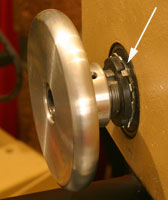 |
This almost unnoticed end play adjuster will be worth its weight in free walnut in years to come when you can quickly dial out play should it develop. No downtime or trips to the service center! Click image to enlarge |
A very thoughtful feature of the bearings is a user adjustable end play nut behind the large machined aluminum hand wheel. You don’t have to take anything apart to make the adjustment either. Just bend up a locking tab, turn the nut slightly and then bend down the next available tab. No muss, no fuss, virtually no downtime and more importantly, no waiting for a service call or dragging/shipping this massive headstock to a service center.
The headstock has a pushbutton spindle lock that engages two detents 180-degrees apart for installing or removing accessories from the spindle threads. The Powermatic 3520B Lathe has a separate indexing system in the form of a screw-in pin that goes in one of four holes surrounding the spindle to access up to 36 positions. A chart in the instruction manual lays out which holes are used for what number of holes around the circle.
The front corner of the headstock is beveled to provide plenty of room for working on the back of bowls or other projects. This is a simple but useful feature that makes these cuts far safer.
The headstock on the Powermatic 3520B Lathe does not pivot but can be positioned anywhere along the bed. This is especially handy with the 18” bed extension for turning bowls or platters off the end of the bed.
Impressive Tailstock
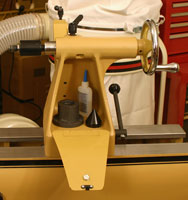 |
The tailstock is also heavily built, has 4 1/2" of travel at the 1 3/8"-diameter ram, has a nifty covered compartment and can be clamped down hanging off the end of the bed to increase between center capacity. Click image to enlarge |
While the tailstock on the Powermatic 3520B Lathe appears normal in shape, it is anything but. To start with, it has a cast-in storage compartment covered by a hinged door that is exceedingly handy.
The large 1 3/8”-diameter quill (ram) has a #2 Morse taper and a 3/8”-diameter through hole for lamp boring. Operated by a large cast iron handwheel, the quill has a full 4 ½” of travel and a laser engraved scale on its upper surface. Retract the quill fully and whatever is in the Morse taper is gently freed for removal.
The tailstock is locked to the bed with a conventional clamping block but it is located at the headstock end of the housing. This eliminates rocking of the tailstock when the quill applies pressure. Offsetting the locking block allows the tailstock to hang off the end of the bed by a few inches and still be locked solidly in place, extending the distance between centers.
Versatile Live Center
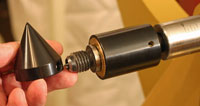 |
Featuring multiple rows of bearings and a screw-on cone adaptor, this live center is usually an aftermarket piece that adds another $100 or so to the price. It comes standard with the 3520B. Click image to enlarge |
The Powermatic 3520B Lathe comes with a high-end, multi-bearing live center that is remarkably tough. It also has a screw-on cone adapter that eliminates the need for another tool when working with projects with a center hole such as peppermills. A very nice touch that actually saves a few bucks!
Tool Rest Base (Banjo)
The Powermatic 3520B Lathe banjo fits with the “big” theme. Though long enough to make use of the 20” swing, its height at the bed is only 2 ½”. That minimizes interference with the stock being turned. That potential interference is further reduced by the tool rest boss being offset towards the headstock, effectively moving the banjo base further from the stock by another inch or two.
The tool rest boss is bored for 1”-diameter posts but has a groove machined in that allows securing smaller diameter tool rest posts. Install the locking bolt/handle in the front hole (there are two more, one on either side) and the smaller rest is pressed against the edges of that groove to lock it firmly in place.
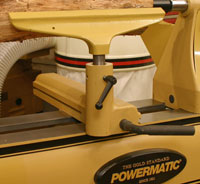 |
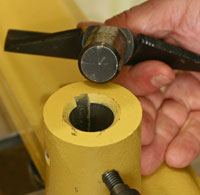 |
(left) The tool rest (banjo) supplied with the 3520B is heavy-duty but very easy to use. It also has a low profile for less interference with the stock being turned. (right) The 1"-diameter hole for the rest post has a special groove that allows it to secure smaller diameter tool rest posts you may already have. Click images to enlarge |
|
The sides of the banjo base have grooves that accept the accessory dust shroud described later in this review.
Tools & Accessories
The Powermatic 3520B Lathe comes with several additional pieces to make it fully functional right out of the box. The quality of these pieces is as remarkable as is the lathe itself.
In addition to the live center described earlier, a 14” ductile iron tool rest, a well-made drive spur and a 3”-diameter faceplate (also heavy-duty) are included. The faceplate has a pair of setscrews to help lock it to the spindle for reverse turning operations. A surprisingly large – and heavy - cast iron wrench for installing/removing the faceplate is included and is definitely out of character in the woodworking manufacturer community.
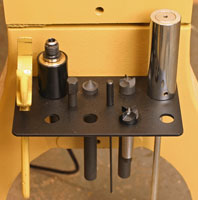 |
The very unusual cast iron wrench and slide-hammer knockout rod along with other included accessories store in a nice caddy that bolts to the leg below the headstock. Click image to enlarge |
Equally uncommon is the chrome plated knockout rod that incorporates a slide hammer. A brass tip prevents damage to whatever accessory is being removed but the solid steel (say heavy) handle slides a few inches on the rod to deliver solid blows without the impact of a normal knockout rod. Hold the brass tip against the piece to be removed and give the handle a flick to knock it out.
A heavy wire safety cage is also standard with the Powermatic 3520B Lathe and offers substantial protection against larger pieces that might fly off during many operations, not the least of which is rounding large bowl blanks. The cage is suspended from a mount on the rear of the headstock and retained with a spring-loaded pull pin and collar. That shaft has two detents so the cage can be locked up or down.
The Comparator
A second mount on the rear of the headstock matches the one on the headstock and makes up the Comparator feature. When the included dead centers are installed in these mounts, they hold a sample of the piece being duplicated between centers. The dead centers can be adjusted so that the sample is aligned with the one being worked on. This is an exceptionally useful feature that seems to get very little praise for some reason. Not here – I love it!
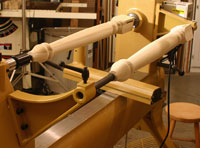 |
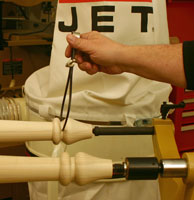 |
(left) The Comparator mounts, standard on the 3520B, make duplicating table legs or other spindle projects much easier. (right) The sample can be adjusted to be directly in line with the piece being turned. You will learn to love this feature! Click images to enlarge |
|
Handling the Big Stuff
The Powermatic 3520B Lathe has a full 20” swing capacity and can handle spindle work up to about 31”-long between centers with the included multi-bearing live center. You can squeeze in a piece about 33”-long with a standard live center. Considering that table legs have a standard length of 29”, the between center capacity is more than enough to handle the vast majority of spindle projects turners create. However, if you want to turn REALLY long pieces, a 50” extension is available that allows turning things way longer than any of us have any business working with. More reasonable for most turners is the 18”-long bed extension that has some interesting capabilities as we will see later.
Despite its remarkable swing capacity, the Powermatic 3520B Lathe is only 75”-long by 27” deep and 58”-tall in its standard configuration. The spindle centerline is 44” above the floor. Compare the size against many 14” swing lathes and it is apparent that the Powermatic 3520B Lathe will fit in their place, something that happens frequently because this is one of the best-selling wood lathes on the market.
Options
18” Bed Extension Kit
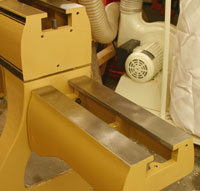 |
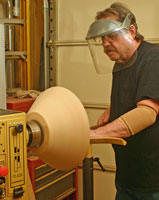 |
The 18" bed extension is a very nice feature as it can be installed in the upper bolt holes to increase spindle capacity, or in the lower holes as shown here (left) to create an English-style, off-the-end bowl lathe with a whopping 38" swing capacity! (right) Another very nice feature of this extension is that it lets you work directly in front of the bowl or platter. Click image to enlarge |
|
The name is a little deceiving as this extension kit (includes a solid steel tool rest extension) is capable of more than simply making the bed of the Powermatic 3520B Lathe longer. In its standard mounts, it does add 18” to the bed for turning projects in the 48 to 50” range. If that’s what you need, it works great.
Another set of mounting holes in the leg locates the extension 9” below the lathe bed converting the Powermatic 3520B Lathe into a hyper-capable bowl and platter machine with a swing capacity of 38”! Slide the headstock to the end of the main bed, slip the banjo onto the extension bed and install the solid steel (and very heavy) tool rest extension into the banjo and you have a fully functional bowl lathe. Another great feature of this arrangement is that it allows standing directly in front of the bowl. I did not recognize how nice (and safe) this working position was until I did it.
Adjustable Dust Port
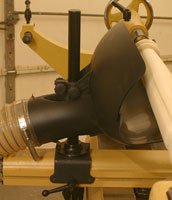 |
The available Dust Port does a great job of removing fine sanding dust. It includes the mount that fits in the banjo grooves on the 3520B. Click image to enlarge |
Sanding on the lathe is a common procedure but one that dust spreads through the shop. What you may not be as aware of is how much of it you inhale. The Adjustable Dust Port comes with a mount that fits into the grooves on the banjo for locating the dust port front to back. The mount also has a post so the dust port can be set at the best height for the job. The dust port can be further positioned by moving the banjo itself.
The dust port has a 4” hose connector at the rear and an adjustable top half that can be set to best fit the profile being sanded. Connect a good dust collector and the adjustable Dust Port is very effective.
In the Shop
The testing portion of the Powermatic 3520B Lathe review took longer than normal because I was having fun from the start. Also, I had trouble finding stock large enough to tax the capabilities of this machine. Simply put, the Powermatic 3520B Lathe does everything claimed by Powermatic and does it all smoothly and accurately.
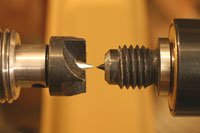 |
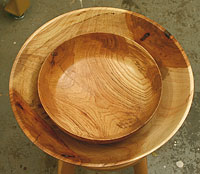 |
(left) The accuracy of the 3520B is shown in how the points align anywhere on the bed. If this isn't perfect, it is VERY close! (right) Swing capacity does not relate directly to the size of bowl that can be turned but rather to the size of the blank you begin with. The trimmed blank for the 11 1/2"-diameter bowl in the middle maxed out my 14" lathe capacity. The outer 17 3/4"-diameter bowl came from a blank that left a good 2" of free space between it and the bed. I couldn't find a bigger blank at the moment! Click images to enlarge |
|
The fit and finish of the Powermatic 3520B Lathe is great. Everywhere you look there is heavy walled cast iron components that have been precisely machined. Everything fits properly and all of the moving parts are exceptionally smooth in operation. Even the fit between the tailstock and the bed is very close and play-free. The drive center and live center points line up perfectly and repeat anywhere along the bed without the operator having to tweak either to achieve that perfect alignment.
The locking levers on the headstock, tailstock and banjo are large, easy to use and very effective. None of them require an extra rap or push to keep things solidly in place.
Video Tour! |
The variable speed control is far more useful than I anticipated. Having it available makes you use it more and that translates into more safety because you use the best rpm not the next best setting available. I also found out how nice 25 to 50 rpm is for drawing layout lines or applying finish. Turn the speed control dial where you want it and it stays right there.
I put the 18” extension in the lower mounts and instantly fell in love with that configuration when turning the first large bowl. Standing directly in front of the object being turned gives the operator a much better angle for applying turning chisels along with very good visibility of the work area. Both of these advantages make turning large objects safer as well.
The pure heft of the Powermatic 3520B Lathe makes it exceptionally stable without stacking on additional weight. I did manage to induce a small shake by turning a badly out of round 44 lb bowl blank at nearly 500 rpm. Reduce the rpm just a little and the Powermatic 3520B Lathe settles right down for the initial rounding.
Everything about the Powermatic 3520B Lathe is first rate, including all of its functions. It is remarkably smooth, quiet and there is no doubt it has more than enough power for any reasonable (and some not so reasonable) turning jobs wood turners may encounter.
Conclusions
If you are considering a full sized lathe, the Powermatic 3520B Lathe should be at the top of a very short list of candidates. Then, you can eliminate the rest. Even turning novices should seriously consider the Powermatic 3520B Lathe. Like most turners, I owned a series of progressively larger machines before getting the Powermatic 3520B Lathe. Each new lathe was chosen to expand my turning capabilities. The unfortunate thing about working your way up to the right machine is that you spend far more along the way. The capacity, capabilities and high-end quality of the Powermatic 3520B Lathe make this a worthy investment and a very good way to save money.
At $2799.99, (4-15-2007) the Powermatic 3520B Lathe certainly is not cheap but in terms of bang for the buck this machine is going to be very difficult to beat, if that can be done. I do not know of a better value, nor a better lathe for the home woodworking shop. I do know of many lesser machines that will wet your appetite for the Powermatic 3520B Lathe though. The extraordinary quality of construction and design along with its large capacities mean the Powermatic 3520B Lathe is a machine that will last you forever and serve the needs of your children with ease.
Remember those questions about which lathe to get I mentioned earlier? The Powermatic 3520B Lathe is the answer.
Have a comment on this review? –Email Me!
All written, photographic and drawn materials are property of and copyright by NewWoodworker.com LLC 2000-2019. Materials may not be used in any way without the written permission of the owner.

